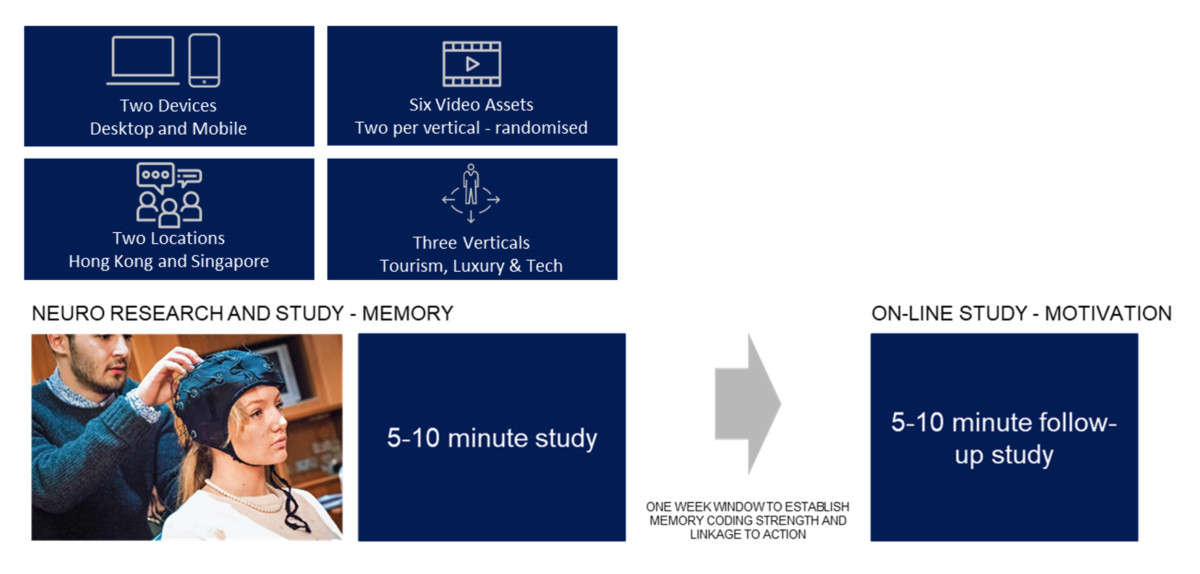Over the years, we have embarked on a multi-stage research partnership with Kadence International by employing methods including quantitative, qualitative as well as neuro to demonstrate the ROI impacts on advertisers’ brand values, positioning and the impact that advertising have on audience’s memory coding when a brand is advertised through the Bloomberg Media properties.
Our research has collectively demonstrated that the right campaign message shown on Bloomberg Media would have a significant impact on the brand’s metrics.
The background
As one of the world’s leading business news organizations and media outlets, our in-house research & insights team provides on-going intelligence on important topics that go to the heart of our business-focused audience: such as tech disruptions at workplace, business investment priorities, travel attitudes, viewpoints on art & technology, and in recent months COVID-19’s disruptions on the business world. Bloomberg Media is not only in a position to provide insights and trends on the broader market landscape, but also to prove that as an advertising platform, Bloomberg Media can offer more than just ‘clicks’ as KPI’s.
The hypothesis was that the mindset of consumers when they engage with Bloomberg Media content would influence how consumers & decision-makers see the brands that advertise with us.
As increasingly large proportions of advertising budgets have been shifted to programmatic deals, the conversation has moved away from the ‘effectiveness of media’ to volumes and speed. At what lowest costs can a campaign be delivered and how quickly can short-term click-through-rates be achieved, while less emphasis is placed on whether the ad is effective in the long term or how it fits into the broader brand health funnel?
Bloomberg Media continuously invests in research that examines brand impacts through the understanding of human behaviour & decisions, which in turn adds insights and understanding on how to make advertising more effective. This isn’t just our view. According to the IPA, advertising effectiveness has nearly halved in the last five years and our collective marketing worth is being questioned.
The ultimate goal is to demonstrate to our clients that what matters is not just about the volume of impressions but the environment where you experience it. We wanted to bust the myth that all impressions leave the same result. We wanted to be able to produce a compelling, data-driven argument as to why a campaign through Bloomberg’s integrated platforms would be a highly effective approach to achieve greater long-term brand results.
The strategy
This is a lofty goal, to swim against the tide and demonstrate that there are more important things than clicks to achieving brand goals when it comes to marketing.
We also wanted to do this comprehensively by using multiple research methodologies available to us. Not only to provide an overwhelming body of evidence but also to drown out nay-sayers who might pick apart a single methodology approach.
Therefore, our strategy involved three parts:
- Qualitative conversations with our audience
- Quantitative data to support our campaign effectiveness
- Extensive neuro assessment of the impact of advertising exposure
Beyond utilizing the multi-facet methodologies, we also felt it was important to demonstrate both the immediate impact and the long-lasting impact of advertising effects have on brands. As a result, we split the overall approach into two separate parts:
- Immediate impact – neuro and survey data to assess the role of advertising medium on brand impact
- Long-lasting impact – multi-wave quant and qual studies to demonstrate the on-going role of advertising medium to affect real-world changes and action intents.
The Method

Extensive Neuro Method: 200 people, 2 Locations – Singapore + Hong Kong, Central Location Test – combined with a follow-up test.
Comprehensive Quant: 822 business-decision makers across USA, UK, France, Germany, Italy, India, Malaysia, Singapore, Hong Kong and Australia, Bloomberg and Non-Bloomberg audience
Qualitative Conversations: 26 business influencers across US, UK, Singapore and Australia
The result
We succeeded in our goal to demonstrate that the right campaign message shown on Bloomberg would have a significant impact on the brands metrics.
Beyond that, the study has allowed us to promote the internal research division of Bloomberg Media as instrumental in measuring the success of advertising campaigns. It has been a key factor in fostering on-going client partnerships.
Thinking ahead into the future, when 3rd party data is diminishing in a cookieless advertising world as data privacy regulations continue to tighten, there will be a higher demand for the types of ad effectiveness surveys that we have devised as part of this programme. A programme with the goal to collect brand effectiveness among the target audiences as well as to devise highly effective solutions to measure campaign KPIs. This will be especially relevant for the B2B audience segments that Bloomberg Media reaches which are hard to be collected by 3rd party data out there anyway in the digital world.
In terms of some business metrics to measure the success of this programme:
- Research that have justified the value of media partnerships and directly linked to returning businesses.
- Brand trackers that have offered insights from the B2B lens and aided in shaping and enhancing multi-year marketing partnerships.
- Research that has led to generations of well-informed business and content ideas for clients.
The takeout
Perhaps one of the key things that we learned from embarking on this journey is that there is no single approach or method that is enough for us to grasp the full understanding our markets. In-house research and marketing teams should continue to partner and work hand-in-hand with professional market research agencies to brainstorm and design research that will reveal brand values from the short-term practical angles and how that fit into archiving the more important long-term marketing goals.


